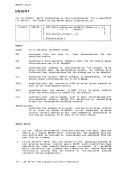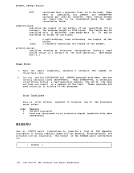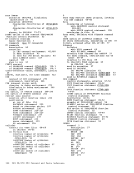LINEDIT Macro MF=
generates code to fill in the parameter list attne specified message text.
The address specified (either a symbolic address or in register
notation) indicates the location of the list form of the macro.
The following example shows how youmight use the list and execute
forms of the LINEDIT macro to write reentrantcode: WRITETOT LINEDIT TEXT='SUBTOTAL ••••• TOTAL ••••• ', SUB= (DEC, (4) ,DEC, (5t),MF=(E,LINELIST) LINELIST LINEDIT MF=L,MAISUBS=6 When the execute form of the LINEDIT macro instruction is used, the
parameter list for the message is built at labelLIMELIST, where
the list form of the macro was coded.Use the MAISUBS operand when you code the list form (MF=L) -form of the
LINEDIT macro instruction. The format of theMAISUBS operand is: MAXSUBS=number where number specifies the maximum number of substitutions that will be
made when the execute form of the macro is used.Use the RENT operand when you are going to use the standard form of the
LINEDIT macro instruction and you do not care whether the code that is
generated is reentrant. The format of the RENT operand is:
WhenRENT=YES (the default) is in effect, the LINEDIT macro expansion
issues anbeing generated. This occurs when you use the standard form of the macro
instruction and you specify one of the following:• TEXTA= (reg) • BOFFA= (reg) • More than one substitution pair
If you do not care whether the code is reentrant, and you do not wish
to have theMNOTE appear, code RENT=NO. The RENT=NJ coding merely
suppresses theMNOTE statement; it has no effect on the expansion of the
LINEDIT macro instruction.
section 6.CMS Macro Instructions 329
generates code to fill in the parameter list at
The address specified (either a symbolic address or in register
notation) indicates the location of the list form of the macro.
The following example shows how you
forms of the LINEDIT macro to write reentrant
parameter list for the message is built at label
the list form of the macro was coded.
LINEDIT macro instruction. The format of the
made when the execute form of the macro is used.
LINEDIT macro instruction and you do not care whether the code that is
generated is reentrant. The format of the RENT operand is:
When
issues an
instruction and you specify one of the following:
If you do not care whether the code is reentrant, and you do not wish
to have the
suppresses the
LINEDIT macro instruction.
section 6.






















































































































































































































































































































































































































